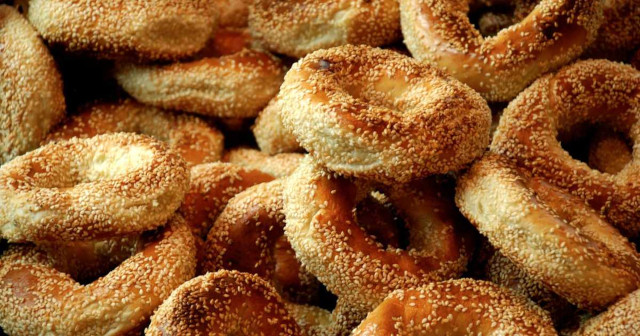January 15 is National Bagel Day. That should be excuse enough for anybody who doesn’t regularly chow down on the doughy delicacy for breakfast or coffee break to make an exception today. Although native to eastern European culinary traditions, the Bagel has become a global standard…
 A batch of Montreal-style Sesame seed Bagels from the ‘Famous Fairmount
A batch of Montreal-style Sesame seed Bagels from the ‘Famous Fairmount
Bagel Bakery’ in Montreal: Get them while they’re still hot!
It would be a real shame if the unique, ubiquitous Bagel was not honoured with its own commemorative day, when such relative trivialities as Peanut Butter and Jelly, Cold Cereal and even Tater Tots get a special day.
So it is with great pleasure that I celebrate National Bagel Day 2020 with a quick history of the ancient and venerable Bun, and offer some of my fave ways to savour it…
Whence came this tasty gem?
The Bagel is essentially a Yeast-raised Bread product designed for eating from the hand. Wikipedia describes it as: “…traditionally shaped by hand into the form of a ring from yeasted Wheat dough, roughly hand-sized, that is first boiled for a short time in water and then baked. The result is a dense, chewy, doughy interior with a browned and sometimes crisp exterior.”
There is little argument that the Bagel, as we know it, originated in the Jewish communities of Poland in the 16th Century. The earliest known official mention of the product comes in the Jewish community ordinances of 1610 in Krakow, where Bagels were already extremely popular.
By the end of the 17th Century, Bagels were a staple in Jewish households across eastern and Central Europe, and sometime in the 18th century they started to come west with Jewish emigrants. By the mid 19th Century, Bagels were being sold regularly in London’s Brick Lane district, and they were well known in New York and other major Eastern U.S. cities by 1900.
For the next half century, Bagels remained mainly a Jewish cultural specialty, but after the Second World War, when millions of soldiers came home bringing with them tastes for foreign foods theretofore unknown in mainstream North American life, the Bagel experiences a rapid rise in public awareness and popularity.
According to an in-depth 2012 article in Consumer Reports, “the ideal Bagel should have a slightly crispy crust, a distinct ‘pull’ when a piece is separated from the whole by biting or pinching, a chewy inside, and the flavor of bread freshly baked.”
Where are we with it today?
Jewish community traditions still rule the Bagel world today, in spite of the tremendous diversification that’s taken place in the product and its uses. There was one style, and one style only before about 1950. Then, modern marketers and foodies got their hands on it – literally – and started adding other Grains to the traditional hard Wheat Flour and adding toppings such as Seeds and Salts. Today, ‘original style wood-oven’ Bagel bakeries offer at least half a dozen styles from Plain to Everything.
Food opinion leaders recognise several variations on the original Bagel style, including the New York, Montreal and St. Louis types. There are also those accept the London style still sold in Brick Lane as a distinct variety, and the Chicago.
How do we eat them?
Once Bagels were eaten simply as Bread; no adornments or any kind. But the foundational Jewish community came up with a special presentation that was adopted in the U.S. early on as the Bagel Brunch, and which today is still called ‘Lox and a Schmear’, or Smoked Salmon and Cream Cheese. But that’s just the beginning. Any of the myriad Bagel ‘flavours’ can be – and are – eaten with anything you would normally spread or pile on bread. By that I mean they may get Peanut Butter and Jelly for Breakfast, just a Schmear for Coffee Break, or the full-on Bagel Brunch for Brunch, Lunch or afternoon Tea.
Perhaps the biggest change in the way Bagels are eaten has come in the past decade or so, we folks started using them in place Hamburger Buns, Croissantes and other traditional Breads and Pastries as Sandwich ‘bookends’. The proliferation of Bagel Sandwiches on Bistro, Diner and Café menus over the past 15 years or so has resulted in many more consumers being introduced to the product.
Or, as ever, you can just grab one, fresh out of the baking oven and munch on it.
Not unique?
Some Bread aficionados argue that the Bagel is not unique; that it must share its fame and fortune with the Soft Pretzel. I disagree. While the nay-sayers do point to the Russian Bublik, the Finnish Vesirinkeli, the Austrian Beuge and the Turkish Açma, among other similarly prepared ring-shaped breads, most of those are contain Dairy products, Lard and other foods prohibited by Jewish Dietary Laws for use in traditional Bagels.
Romanian Covrigi and the German-style Soft Pretzel are also mentioned as cousins of the Bagel, but they are at best, distant ones.
So get out there and grab a dozen!
It’s already to late in the day to get the fresh-from-the-oven Bagels at your nearest traditional, wood-fired Bagelry. But they’ll still have lots of today’s batch on hand, just waiting for your attention. However you like them, today is the day to celebrate them!
~ Maggie J.

